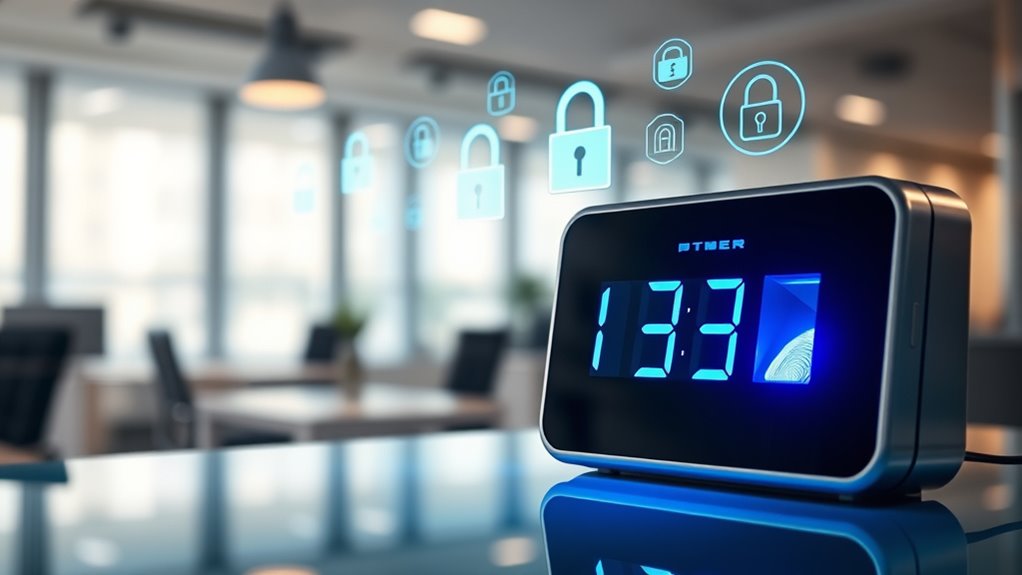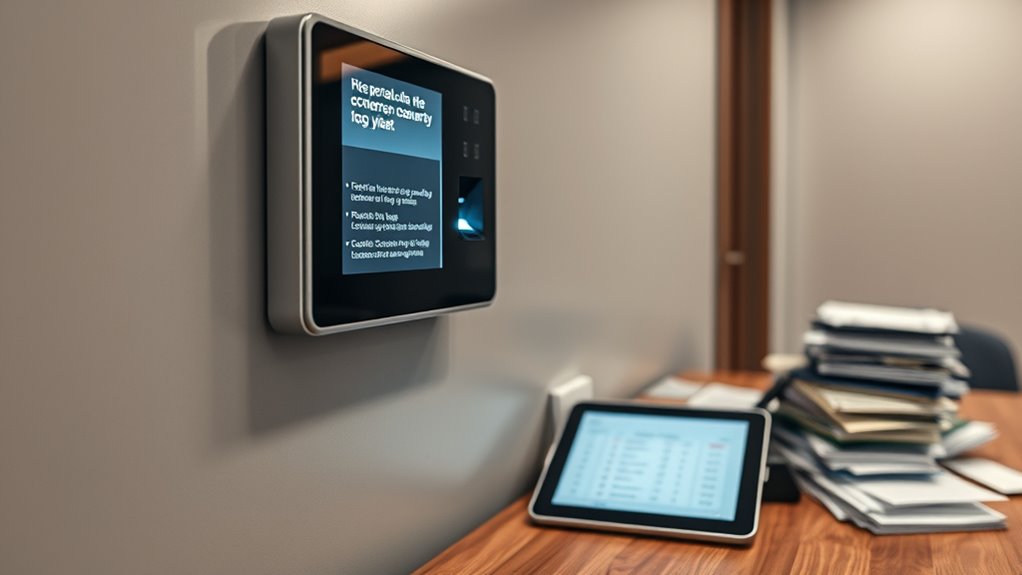To comply with biometric time-clock regulations, guarantee you obtain clear, informed employee consent and inform them of how their data is used and protected. Implement strong security measures like encryption and restrict access to prevent breaches. Keep accurate records, regularly verify system accuracy, and follow data retention laws. If your organization operates across borders, stay updated on local privacy laws. Continue exploring to understand how to navigate these complex compliance requirements effectively.
Key Takeaways
- Obtain clear, informed employee consent before collecting biometric data, explaining purpose and privacy protections.
- Ensure biometric data is securely stored, encrypted, and accessible only to authorized personnel.
- Comply with applicable privacy laws like GDPR and PDPA, especially during cross-border data transfers.
- Regularly verify system accuracy, update security protocols, and maintain detailed audit logs for compliance.
- Provide transparency, clear policies, and dispute resolution processes to uphold employee rights and prevent legal issues.
Privacy Regulations and Employee Consent

Because biometric time-clocks collect sensitive personal data, organizations must comply with privacy regulations that govern how employee information is handled. You need to obtain clear, informed consent from employees before collecting their biometric data. This means explaining why you’re gathering the data, how you’ll use it, and how you’ll protect their privacy. Employees have the right to refuse consent without facing discrimination or retaliation. You should also provide options for employees who choose not to participate, ensuring compliance with applicable laws. Transparency is key; you must keep employees informed about any changes in data collection practices. Additionally, implementing security measures to safeguard collected data is essential to prevent breaches and unauthorized access. By prioritizing consent and clear communication, you help build trust and avoid legal issues related to privacy violations.
Data Security and Storage Requirements

To protect employee biometric data, organizations must implement robust security measures for storage and handling. Use encryption to secure stored data both at rest and in transit, preventing unauthorized access. Limit access to biometric information, ensuring only authorized personnel can view or modify it. Regularly update security protocols to address emerging threats and vulnerabilities. Maintain detailed logs of data access and transfers to enable audits and detect suspicious activity. Store biometric data separately from other employee records to reduce risks if breaches occur. Use secure servers with firewalls and intrusion detection systems. Establish clear policies for data retention, ensuring biometric information isn’t kept longer than necessary. Properly disposing of outdated data minimizes potential misuse and aligns with compliance standards. Additionally, implementing proper access controls ensures that only designated staff can handle sensitive biometric data, further reducing risk.
Accuracy and Recordkeeping Standards

Ensuring the accuracy of biometric time-clock records is essential for maintaining fair payroll and compliance with labor regulations. Accurate data prevents payroll errors, disputes, and potential legal issues. To meet standards, you must regularly verify the system’s functionality, audit records for inconsistencies, and ensure proper calibration of biometric sensors. Proper recordkeeping also involves securely storing data for mandated periods and maintaining detailed logs of system access and modifications. This helps in tracking any discrepancies and proves compliance during audits. Remember, incomplete or inaccurate records can lead to penalties and undermine employee trust. Emphasize the importance of timely updates, consistent monitoring, and adherence to legal requirements to keep your biometric systems reliable and compliant. Utilizing data-driven strategies can further enhance the accuracy and effectiveness of your recordkeeping processes.
Cross-Border Data Transfer Challenges

Maintaining accurate biometric time-clock records isn’t enough if your organization operates across borders. You face the challenge of transferring sensitive biometric data between countries with different privacy laws. Some jurisdictions have strict regulations that limit or prohibit cross-border data flows without specific safeguards. You must guarantee compliance with local laws like the GDPR in Europe or the PDPA in Singapore, which require explicit consent and data protection measures. Failing to do so can lead to legal penalties, fines, and reputational damage. To navigate these challenges, implement data transfer agreements, encryption, and privacy impact assessments. Regularly review legal requirements in all countries where you operate, and stay updated on evolving regulations to avoid inadvertent violations. Additionally, understanding regulatory standards related to biometric data can help ensure comprehensive compliance.
Employee Rights and Dispute Resolution

When implementing biometric time-clock systems across multiple jurisdictions, understanding employee rights and establishing clear dispute resolution processes become essential. Employees have the right to privacy, informed consent, and access to their biometric data. Clear policies help prevent misunderstandings and legal issues. You should also set up straightforward procedures for resolving disputes related to biometric data collection, usage, or accuracy. These processes ensure employees feel heard and protected. Emphasize transparency and communication throughout the process. Incorporating online resources can assist in educating employees about their rights and the proper handling of biometric data.
Frequently Asked Questions
How Do Biometric Laws Vary Across Different States?
Different states have varying biometric laws that impact how you can use fingerprint or facial recognition systems. Some states, like Illinois, have strict laws requiring informed consent and data security measures. Others, such as Texas, have more relaxed rules. You need to stay informed about your state’s specific regulations to guarantee compliance. By understanding these differences, you can protect employee privacy and avoid legal issues with biometric data collection.
What Are the Penalties for Non-Compliance?
Imagine steering a river with unpredictable currents; if you ignore the rules, you risk capsizing. Similarly, if you don’t comply with biometric laws, you face fines, legal actions, and damage to your reputation. Penalties vary by state but often include hefty fines, lawsuits, and operational restrictions. Staying compliant isn’t just wise; it’s essential to avoid these turbulent waters and keep your business afloat.
How Often Should Biometric Data Be Reviewed or Updated?
You should review and update biometric data regularly to maintain accuracy and security. Ideally, check your biometric records at least once every six months, or whenever there’s a change in employee data or reported issues. Regular updates help prevent unauthorized access and ensure compliance with regulations. Staying proactive by establishing a consistent review schedule reduces errors, enhances security, and keeps your system running smoothly.
Can Biometric Data Be Used for Purposes Other Than Time Tracking?
Using biometric data is like opening a treasure chest—you want to guarantee it’s used wisely. You can use it for purposes beyond time tracking, like security access or identity verification, but you must follow laws and privacy policies. Always inform employees about how their data will be used, and get their consent. Misusing biometric data risks legal trouble and erodes trust, so handle it responsibly and transparently.
What Are Best Practices for Employee Training on Biometric Systems?
You should focus on clear, engaging training sessions that cover how to properly use the biometric system. Show employees how the technology works, emphasize privacy and security protocols, and encourage questions to guarantee understanding. Provide written guides or videos for reference, and regularly update training as systems evolve. By fostering transparency and confidence, you help employees feel comfortable and compliant with biometric system use.
Conclusion
Managing biometric time-clock compliance can be overwhelming, but understanding the regulations helps protect both your business and employees. Did you know that over 60% of organizations have faced data breaches related to biometric data? By prioritizing privacy, security, and transparency, you can reduce risks and foster trust. Stay informed and proactive—your commitment to compliance not only safeguards sensitive information but also builds a respectful work environment where everyone feels secure.









